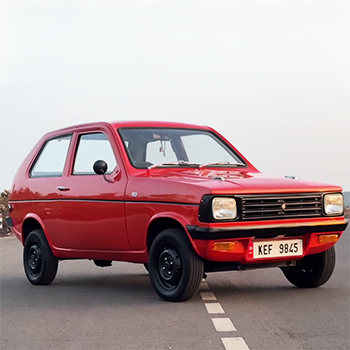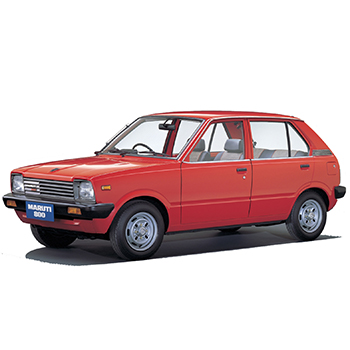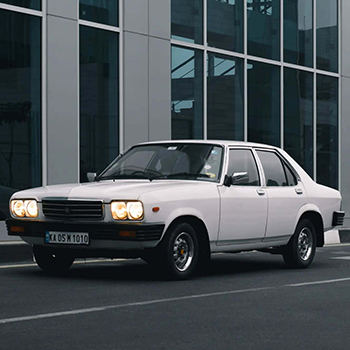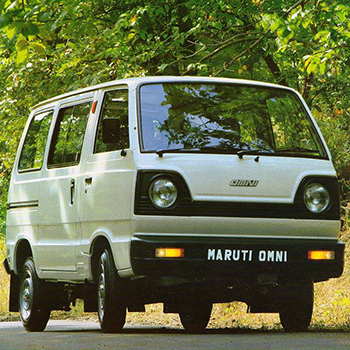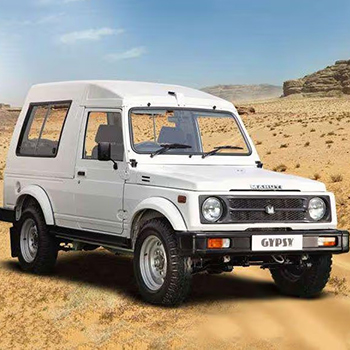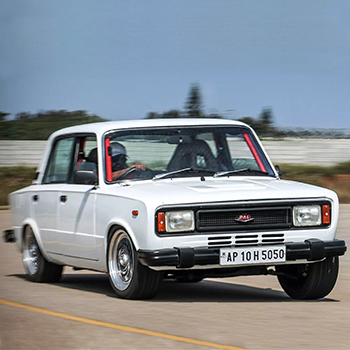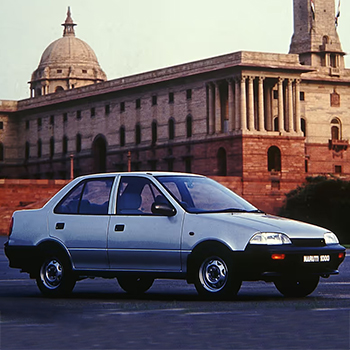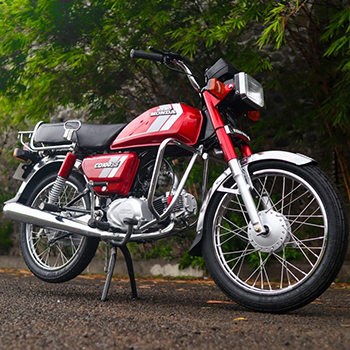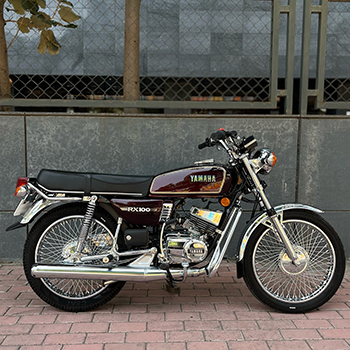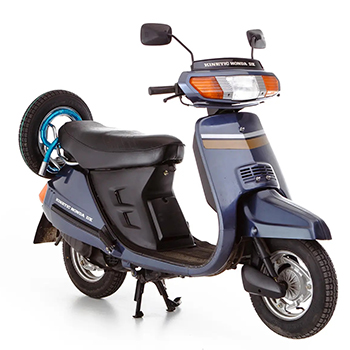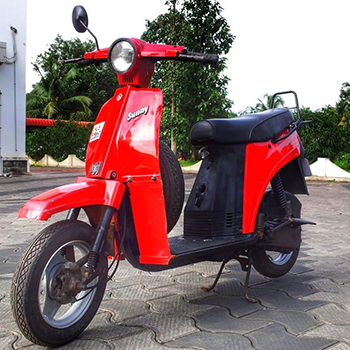Transport Automobiles
1981-1990
(12 items)
Transport Automobiles1981-1990
(12 items)
(12 items)
Sipani Dolphin 1982
The Sipani Dolphin, launched in 1982, was a compact hatchback manufactured by Sipani Automobiles Ltd in Bangalore, India. The Dolphin, which was based on the UK's Reliant Kitten, was notable for having a fibreglass body, which made it lightweight and resistant to rusting. Its design was compact and sporty, with a two-door configuration, sloping rear hatch, and a simplistic yet forward-looking aesthetic for early 1980s India. An 848 cc four-cylinder petrol engine with rear-wheel drive was installed in the front. The fibreglass panels created problems with durability and repair even though they assisted in lowering production costs and vehicle weight. The fibreglass body was attached to a steel frame that served as the chassis. The interiors were basic, with functional instrumentation and modest fabric or vinyl seating. The Dolphin is still a fascinating episode in Indian automotive history, despite its commercial struggles brought on by a lack of dealer backing and the market's reluctance to accept non-metal bodies.
Details >>Maruti 800 1983
The Maruti 800, launched in 1983, a contemporary, small, and fuel-efficient hatchback for the general public, signalled a dramatic change in the Indian automobile industry. The Suzuki Fronte/Alto SS80 served as the model for its simple yet useful design, which was perfect for Indian city roads because of its boxy profile, small size, and sparse decoration. Known for its dependability and economy, the car's 796 cc, 3-cylinder, F8B petrol engine was produced by Maruti Udyog Limited in partnership with Suzuki Motor Corporation of Japan. While parts like the dashboard and bumpers were moulded from sturdy polymers, the body shell was composed of monocoque pressed steel panels. The Maruti 800's mass appeal, affordability, and ease of maintenance made it a representation of India's economic liberalisation and the aspirations of the middle class. At the time of its launch, it cost Rs. 48,000, which was a rather substantial amount.
Details >>Hindustan Contessa 1984
One of India's first luxury sedans, the Hindustan Contessa was introduced by Hindustan Motors in 1984 and was based on the UK's Vauxhall Victor FE from the 1970s. Buyers looking for a high-end vehicle with a Western taste were drawn to its design because of its long, wide body, straight lines, and regal demeanour. It started out with the outdated 1.5L BMC engine, which was also utilised in the Ambassador. Later, it was upgraded with a 1.8L petrol engine and 5-speed gearbox from Isuzu, which greatly increased performance and refinement. The Contessa featured a steel monocoque chassis, pressed steel body panels, and chrome accents, while interiors were furnished with moulded plastic dashboards, fabric upholstery, and faux wood trims. The vehicle, which was manufactured at Hindustan Motors' Uttarpara facility in West Bengal, reflected a period of transition in Indian auto production by combining local assembly with imported components. During the 1980s and early 1990s, politicians and business leaders favoured the Contessa because of its comfort, spaciousness, and official appeal.
Details >>Maruti Omni 1984
The Maruti Omni, launched in 1984 by Maruti Udyog Limited (now Maruti Suzuki India Limited), was India’s first microvan designed for both commercial and family use. The Suzuki Carry, particularly the ST90 generation of the early 1980s—a well-liked kei van/microvan made by Suzuki Motor Corporation, Japan—was the inspiration for the design and concept of the Maruti Omni (1984). Its cab-over-engine configuration and small, boxy shape maximised cabin space. Large windows for visibility, a flat front, and sliding doors were all part of its functional design. The Omni was equipped with a 796cc, 3-cylinder petrol engine, shared with the Maruti 800, offering modest performance with high fuel efficiency. For economical mass manufacturing, the car was built at Maruti's Gurgaon facility using a monocoque chassis mainly composed of mild steel sheets. The interiors had simple vinyl and plastic components, while the body panels were stamped and welded with rudimentary corrosion protection. The Omni has been a common option for ambulances, school vans and the transportation of products on Indian roadways for more than thirty years due to its lightweight design, ease of maintenance and versatility.
Details >>Maruti Gypsy 1985
The Maruti Gypsy, launched in 1985, was a rugged off-road vehicle based on the Suzuki SJ410 (Jimny) platform, adapted for Indian terrain by Maruti Udyog Limited in collaboration with Suzuki Motor Corporation, Japan. Its design featured a boxy, utilitarian body, flat panels, round headlamps, and a signature slatted grille, suited for durability and ease of repair. The Gipsy was perfect for rugged terrain, military applications, and rural use since it was built on a ladder-frame chassis and had high ground clearance, leaf spring suspension, and part-time 4WD. The early model was powered by a 970cc, 4-cylinder F10A petrol engine, paired with a 4-speed manual gearbox. It was manufactured at Maruti's Gurgaon plant with a steel chassis, pressed mild steel body panels, and simple vinyl, fibreboard, and injection-moulded plastic interiors. The Gipsy cemented its status as an iconic Indian 4x4 by becoming a favourite among the Indian Army, police, and rally drivers due to its dependability and ability to travel anywhere.
Details >>Premier 118NE
The Italian Beauty Fiat 124, which is known in India as the Premier 118NE, launched in 1985 by Premier Automobiles Limited (PAL), was a mid-size sedan developed through a collaboration between PAL, Fiat (Italy), and Nissan (Japan). Although it used Nissan-licensed technical parts, such as the 1.2L (1171cc) Nissan A12 inline-4 petrol engine and a smooth 4-speed manual transmission with rear-wheel drive, it was built on the Fiat 124 platform. With Japanese mechanical dependability, the design kept the Fiat 124's round headlights, chrome embellishments, and clean, boxy European style. PAL's Kurla plant in Mumbai manufactured the body using pressed steel panels and a monocoque construction for structural rigidity. Cost-effective manufacturing was evident in the interiors, which featured vinyl-covered seats, simple plastic dashboard components, and analogue instrumentation. Despite having few amenities, the 118NE was well liked by upper-middle-class Indian families in the late 1980s and early 1990s due to its smooth engine performance, smoothness, and comfortable ride.
Details >>Maruti 1000 1990
The Maruti 1000, launched in 1990, was Maruti Suzuki's first entry into the mid-size sedan segment in India and marked a significant step up from its smaller hatchbacks. It was designed as a compact family sedan and was based on the Suzuki Cultus sedan (SA310). It had a clean, boxy appearance with rectangular headlamps, a straightforward grille, and little decoration, which reflected the practical aesthetics of the time. The vehicle was powered by a 3-cylinder, 970cc, carburetted gasoline engine that generated around 46 horsepower and was mated to a 4-speed manual gearbox. Although many essential parts were initially imported, it was manufactured at Maruti's Gurgaon factory with considerable localisation efforts. Vinyl and plastic were utilised for the inside trims, while mild steel was used for the body shell. Dashboards were constructed from injection-molded ABS plastic, while upholstery was manufactured from synthetic cloth. The Maruti 1000 was one of the first sedans in India to offer relatively refined ride quality and better NVH insulation, setting the stage for future compact sedans in the Indian market.
Details >>LML Vespa
An Indian-built imitation of the famous Italian Vespa, the LML Vespa (1984), was created through a technical partnership between Piaggio of Italy and Lohia Machines Limited (LML). It maintained the trademark curving Vespa style while maintaining strength and endurance with the traditional monocoque steel body design, which functioned as both the chassis and exterior skin. It was powered by a 150cc 2-stroke, single-cylinder, air-cooled engine, mated to a 4-speed manual gearbox with the gear selector integrated into the left-hand grip, a typical Vespa feature. For a smooth ride, the scooter had a single-sided trailing-link front suspension, a rear hydraulic shock absorber, and pressed steel wheels with drum brakes. The engine casing was made of die-cast aluminium, the monocoque frame was made of heavy-gauge sheet metal, and the mirrors and trim were made of chrome-plated steel. Smaller components like switchgear and lamp housings were the only ones made of plastic. The LML Vespa maintained the classic Vespa appearance and dependable performance while becoming more reasonably priced by fusing local production with Italian design history.
Details >>Hero Honda CD100
One of the first motorcycles produced by the Hero-Honda joint venture in India was the Hero Honda CD100 (1984), which welcomed a new era of dependable, fuel-efficient commuter bikes. Its design was simple, practical, and aerodynamic; it had a circular headlamp, a flat, single-piece seat for comfort, a short fuel tank with few graphics, and chrome-plated mudguards for a timeless appearance. The bike's 97.2 cc, 4-stroke OHC air-cooled engine prioritises low maintenance and mileage. The body panels, side covers, and fenders were composed of a combination of lightweight plastic and steel to prevent rust, while the double cradle structure was constructed of tubular steel for durability. Chrome was frequently used on the handlebars and exhaust, while mild steel with anti-corrosion coatings was used to construct the chassis and fuel tank. Wheels had spoked steel rims, and rubber parts comprised seat cushions, tyres, and grips. The CD100 was a renowned commuter bike of the 1980s because of its smooth engine, sturdy construction, and good fuel efficiency (around 80–85 km/l).
Details >>Yamaha RX100
The Yamaha RX100 (1985) was a legendary two-stroke motorcycle known for its sporty performance, lightweight design, and iconic styling. It had a 98cc, two-stroke, air-cooled engine with reed-valve induction that produced a distinctive exhaust note and rapid acceleration. With a teardrop-shaped fuel tank, chrome-plated front and rear mudguards, a flat, padded seat, a round headlamp, and vintage spoke wheels, its design was simple and timeless. The tank and main body panels were made of pressed steel for strength, while the frame was made of tubular double-cradle steel for rigidity and agility. Side covers were made of lightweight plastic, and the exhaust, engine casing, and handlebar were primarily made of chrome and polished aluminium. The tyres, seat cushions, and grips were all made of rubber, and the wheels included steel rims with wire spokes. With a kerb weight of about 103 kg and good build quality, it was agile but sturdy, gaining a cult following for its dependability, performance, and simplicity of modification.
Details >>Kinetic Honda
A partnership between Kinetic Engineering and Honda Motor Co. produced India's first contemporary gearless scooter, the Kinetic Honda (1985), which brought a new degree of comfort to city commuting. Its 98cc, 2-stroke, air-cooled engine and continuously variable gearbox (CVT) made it incredibly user-friendly by doing away with the necessity for manual gear shifting. With a completely enclosed body, an integrated headlamp, curved panels, and a wide floorboard for comfort and functionality, the design was elegant and modern for its time. While the body panels were primarily composed of plastic-fibre composites to reduce weight and resist corrosion, the underbone chassis was constructed from high-tensile tubular steel for stability and rigidity. Mild steel with anti-rust coatings was utilised for the fuel tank and a few structural components. The engine casing and wheel hubs were made of aluminium alloys, while chrome was used sparingly, only on the exhaust cover and a few trims. The seat was a single, broad unit with vinyl covering and foam cushions. It was groundbreaking, especially for women and first-time riders in the mid-1980s, thanks to its lightweight design (around 95 kg) and electric-start automatic gearbox.
Details >>Bajaj Sunny
The Bajaj Sunny (1990) was a lightweight, gearless moped designed for urban commuting with simplicity and affordability in mind. It had a flat floorboard, a slender body, a simple step-through frame, and small 10-inch wheels for effortless mobility. It was perfect for short city rides because of its 60cc, two-stroke, air-cooled engine, which produced about 2.8 horsepower and could reach a top speed of about 50 km/h. The chassis was constructed using tubular steel for structural strength, while the body panels were mainly composed of pressed steel with some plastic cladding for weight reduction. It featured a trailing arm rear suspension and a basic telescopic front suspension. The Sunny’s design emphasised low cost, low maintenance, and high fuel efficiency, appealing to students and first-time riders. In order to keep the motorcycle affordable and simple to manufacture, Bajaj Auto used locally available parts with little chrome, simple paint jobs and a single-seat arrangement.
Details >>